



[TOKYO, Japan, 26 April 2011]
Ensuring child-friendly reconstruction in response to the Great East Japan Earthquake.
-The first UNCIEF assistance to Japan in over 50 years-
26 April 2011 (Tue) 13:00 – 14:00
Location: UNICEF House
The Great East Japan Earthquake was a catastrophic disaster that at one point forced approximately 500,000 disaster victims to seek refuge at shelters. Since the disaster, the Japan Committee for UNICEF (JCU) has provided assistance in the form of relief supplies, including drinking water, children’s underwear and sanitary goods, with the cooperation of the UNICEF Headquarters, aid agencies in the disaster area, municipal governments, private aid agencies and disaster victims. In parallel with this, JCU has also assisted preparations for the reopening of schools, pregnant and breastfeeding mothers and infants, and made efforts to protect children placed in vulnerable situations utilizing psychological care. These activities mark the first assistance conducted by UNICEF in Japan in over 50 years.
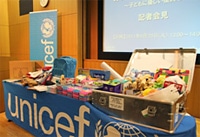 |
| © Japan Committee for UNICEF |
Nearly six weeks have passed since the earthquake and tsunami disaster. Children are starting a new school year and various reconstruction activities are being pushed into full swing in the disaster area. Against this backdrop, JCU drafted a plan to implement Child Friendly Spaces until the end of September of this year. Today (26 April), an overview of that plan was released. Please see here for the latest version of the Emergency Relief Plan of Action.
At a press conference held at UNICEF House in Tokyo, reports were made on the situation at the disaster area by Japanese expert Dr. Osamu Kunii, who was dispatched from the UNICEF Somalia Office and has led assistance activities in Miyagi Prefecture since 19 March, as well as Ambassador to JCU Agnes Chan, who visited the disaster area on the hard-hit coast of Miyagi Prefecture between 12-15 April.
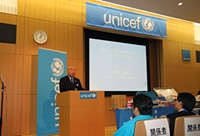 |
| © Japan Committee for UNICEF |
JCU made the decision to implement assistance on the first day after the unprecedented disaster hit the Tohoku region, 12 March. This marked an extraordinary decision, as JCU normally provides assistance for developing countries. Nevertheless, JCU made prompt efforts to procure funds and commence preparations for assistance activities. After establishing bases in Miyagi and Iwate Prefectures, we quickly launched an assistance campaign for children from infants to junior high school age, providing them with school supplies and recreation kits. We also provided vehicles for pediatricians and health nurses to travel to the locations of where children were staying. This was made possible by UNICEF Headquarters, who, in response to our decision, dispatched Japanese staff skilled in assistance activities to Japan from around the world. It was also made possible largely due to the profound cooperation of local co-ops, with which we have long shared a cooperative relationship, as well as powerful corporate partners such as AEON.
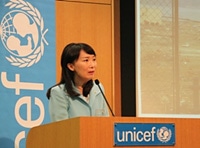 |
| © Japan Committee for UNICEF |
I visited the disaster area in order to speak with children, mothers and teachers. The situation was complete devastation—just as terrible as any of the many difficult situations that I have seen in the past. The tsunami took with it many lives, livelihoods and local history.
Life at the shelters was rough, but everyone was working hard to endure the situation; my heart felt empty when trying to offer them words of encouragement. When I told them, “Thank you for staying alive,” there were people that gave me a big hug and, crying, told me about their experiences. Two brothers that I met at one shelter said that their younger sister and mother had been washed away in the tsunami. The older brother, who was a junior high school student, had his eyes glued to the obituaries column of the newspaper. He said he was looking for his friends who were still missing. When I asked them if there was anything that they wanted, another child next to me said, “What I really want is my mom to be here again.” Then, and without changing the expression on her face, began to cry. There are many more children just like her.
In Minamisanriku Town, which was washed away in its entirety by the tsunami, I heard from many about their concerns, such as mothers worrying about the nutrition of their children and not being able to gather the proper school materials despite school having started. I had been to Kessennuma many times before the tsunami, but this time the port, which had always been a vibrant part of the city, was completely destroyed. The sight brought tears to my eyes. After touring the city I was left with a strong sense that there was still a large disparity among localities in the amounts of assistance. Available assistance depended on which shelter you stayed at, or, whether you were at a shelter or at your own home. Also, the situation for children changed based on those factors.
I want to do my best to extend assistance to areas where it has yet to reach. Moreover, it is also important to restart schools. We must provide support for what is needed in order to reopen schools. Returning to school allows children to return the normality to their lives. This is an essential element of psychological care for children, though at the same time, when children gather together disparities tend to stand out. There are children that receive assistance, children that do not receive assistance, children that have lost their parents and houses, children that live together with their parents in houses, children that eat well, and children that do not eat well. In order to eliminate this type of disparity, I plan to work together with children and those that provide psychological assistance to children to exert every effort in continuing assistance. If you are having any trouble related to children—and I mean any trouble at all—I ask that you please tell me about it. Of course, there are limits to what we can do. Nevertheless, there are many things that we cannot do but our partners can. I will continue my own efforts while working together with municipal governments in the disaster area, people carrying out activities on-site, and the many disaster victims.
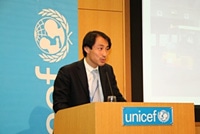 |
| © Japan Committee for UNICEF |
I entered the disaster area on 15 March, just four days following the disaster. In addition to delivering emergency supplies to disaster victims, I received a great response to the suggestion that assistance also be extended by providing toys and other goods to children that faced significant amounts of stress. These needs were often put on the back burner as priority was given to water and food. Nevertheless, from its past experience UNICEF has learned that certain activities, such as having children talk or play with adults that they know, are effective methods in helping them avoid suffering from trauma. In response to the current disaster, I will do everything I can to talk with children and implement activities that are based on their needs.
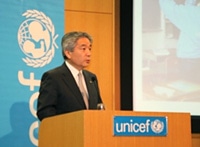 |
| © Japan Committee for UNICEF |
Some time has passed since the disaster and schools are beginning to reopen and people are starting to rebuild their lives. Amidst this situation, the local needs are changing. JCU will continue assistance in a manner that responds to these changing needs.
As the disaster took place in March, the end of the Japanese fiscal year, a major educational issue faced in the beginning was how to start the new school year. UNICEF provided stationery and schools supplies to meet the immediate needs of 200,000 children, while at the same time providing the necessary equipment to the teachers. In the future we must respond with further assistance that is needed for school life, including gym clothes and indoor shoes.
Furthermore, compared to schools, the assistance needs of children not yet old enough to attend school are very high. UNICEF is extending assistance to the reopening kindergartens and preschools just as with regular schools, and is advancing preparations for constructing Child Friendly Spaces.
Another issue that must be immediately addressed is nutrition. Children living in shelters are not receiving a level of nutrition that is needed for growth. We will work with the government to conduct nutrition surveys on restoring school lunches and on other issues.
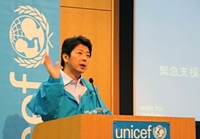 |
| © Japan Committee for UNICEF |
I have participated in assistance activities on-site in the aftermath of various major water-related disasters, including the tsunami in Sumatra, and the cyclone in Myanmar and Bangladesh, but I was left at a loss for words after seeing the disaster site in northeastern Japan. Japan is a developed nation, yet towns have been destroyed and dead bodies are still being found at the disaster site.
UNICEF’s strength is its skill in providing on-site assistance. In order to respond to continuously changing needs it is necessary to send the needed goods in a prompt manner. I traveled to the disaster site numerous times for this very reason. One of the biggest problems was matching assistance with needs. It is vital that efforts are made to conduct thorough surveys and ensure that the necessary assistance is provided where it is needed. For instance, in order to assess the nutritional situation of children or locate children and mothers that are still left without assistance, we have actively assisted assessments on shelters and disaster areas conducted by the prefectural governments and other municipalities, as well as extended assistance in implementing surveys carried out via door-to-door visits. In Japan, the reconstruction of kindergartens and preschools is often given low priority. However, children gathering and playing is an important part of psychological care, while having people look after children gives the mothers a chance to rest or clean. I feel that it is our duty to take on the work that others cannot and to pay attention to the sometimes difficult to see needs of children and mothers.
| Receiving Prefecture |
Type of Emergency Supplies |
Arrival Date |
Quantity | Donating Company |
Comments |
|---|---|---|---|---|---|
| Miyagi | Water | 19 Mar. | 12,288 bottles |
VanaH Co., Ltd. | Two-liter plastic bottles |
| Fukushima | Water | 22 Mar. | 12,672 bottles |
VanaH Co., Ltd. | Two-liter plastic bottles |
| Miyagi | Underwear for boys and girls | 22 Mar. | 200,000 | ||
| Iwate | Underwear for boys and girls | 23 Mar. | 30,000 | ||
| Fukushima | Water | 23 Mar. | 4,680 bottles |
KIRIN MC DANONE WATERS Co., Ltd. | Two-liter plastic bottles |
| Miyagi | Children’s shoes | 23 Mar. | 10,000 pairs |
||
| Miyagi | RChildren’s diapers | 24 Mar. | 80 packs | P&G Japan | |
| Iwate | Children’s underwear | 24 Mar. | 9,700 | ||
| Fukushima | Water | 24 Mar. | 12,288 bottles |
VanaH Co., Ltd. | Two-liter plastic bottles |
| Iwate | Shoes | 26 Mar | 1,404 pairs | Achilles Corporation | |
| Iwate | Underwear for boys and girls | 27 Mar. | 28,266 | ||
| Iwate | Boots | 27 Mar. | 7,462 pairs | ||
| Iwate | Wipes | 28 Mar. | 1,200 | P&G Japan | For babies |
| Miyagi | Recreation kits Early Childhood Development kits |
2 Apr. | 50 of each | Procured from the UNICEF Supply Division | |
| Iwate | Recreation kits Early Childhood Development kits |
2 Apr. | 50 of each | Procured from the UNICEF Supply Division | |
| Miyagi | Book bags | 6 Apr. | 70 | Nihon New Bag Chain | |
| Iwate | Book bags | 6 Apr. | 340 | Seiban | |
| Miyagi | Schoolbags | 8 Apr. | 18,000 | Procured from the UNICEF Supply Division | |
| Iwate | Schoolbags | 8 Apr. | 18,000 | Procured from the UNICEF Supply Division | |
| Miyagi | Personal security buzzers (for crime prevention purposes) | 8 Apr. | 5,000 | ||
| Iwate | Personal security buzzers (for crime prevention purposes) | 8 Apr. | 5,000 | ||
| Fukushima | Water | 11 Apr. | 1,536 bottles | VanaH Co., Ltd. | Two-liter plastic bottles |
| Miyagi | Replenishments for recreation kits | 12 Apr. | 60 sets | ||
| Miyagi | Miniature toy cars | 12 Apr. | Approx. 1,200 | TAKARA TOMY | |
| Sagamihara* | Water | 12 Apr. | 12,288 bottles | VanaH Co., Ltd. | Two-liter plastic bottles |
| Miyagi | Play mats | 13 Apr. | Two types; 80 of each type | IKEA | |
| Miyagi | Drawing sets | 13 Apr. | 60 sets | IKEA | |
| Iwate | Chairs (for 3-5 year olds) | 14 Apr. | 75 | ||
| Iwate | Tables (for 6 people) | 14 Apr. | 11 | ||
| Iwate | Low tables | 14 Apr. | 9 | ||
| Iwate | Notebooks and stationery sets for primary and junior high school students | 15. Apr. | 16,700 sets | ||
| Miyagi | 183 computers | 18-21 Apr. | 3 computers at 61 locations | Distributed to kindergartens, primary, junior high and high schools affected by the disaster as well as their new locations | |
| Miyagi | Copier/fax machines | 18-21 Apr. | 57 | Distributed to kindergartens, primary, junior high and high schools affected by the disaster as well as their new locations | |
| Miyagi | Printers | 18-21 Apr. | 61 | Distributed to kindergartens, primary, junior high and high schools affected by the disaster as well as their new locations |
*Areas receiving disaster victims.
*In certain cases some supplies may be taken from prefectural supply storage warehouses and distributed to shelters and disaster sites in other prefectures.
As of 9:00 a.m. on 20 April 2011 (compiled by the Information and Public Affairs Division).